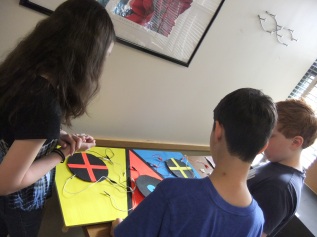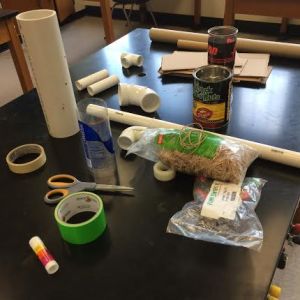Grade 6
Dr. Slotwinski piloted the Maker Space in the Middle School with her project, building digital instruments.
High School Physics lesson by Mike Egan and Vinny Licciardello
Instrument Design and Sound Waves
11th grade Physics 512 students took part in a pilot end of the year project centered around employing design thinking towards a common goal in the field of physics. After learning about sound waves and resonance students were challenged to design their own instrument the could produce 3 distinct notes. As you can see, students adapted in the classroom and learned/strengthened building techniques. The addition of a Design Lab in the High School will prove to be invaluable in facilitating projects such as this one.


The focus of our first maker-style project is to develop a Music Maker Museum in which Sixth Grade Exploring Music students design, create, and display electronic instruments or electrified artwork that make sound. Over an approximately 10 week span (the length of one quarter), this came to fruition! The students worked with a microprocessor called Ototo, conductive paint, copper tape, aluminum foil, wood, and other building materials in small groups, pairs, and individually to design, research, and create instruments or programmable artwork to display in our interactive Museum. Additionally, the students created descriptions of their projects and instructions for visitors to understand their instruments or how to interact with their piece of art. Now that the construction is complete, the Museum is open!
Click below for our blog including pictures, videos, and descriptions of the projects!
http://www.scarsdaleschools.k12.ny.us/Page/19202
LikeLike
Instrument Design and Sound Waves
For this project you will design and test an “instrument” that can play a minimum of 3 distinct notes of known frequencies. You will use your knowledge of wave speed, resonance, tubes (open and closed), and tension in elastic materials to complete this task.
Design and Building Procedures:
The process for design and construction will follow the Play/Draw/Prototype/Reiterate model shown in class by Ms. Yokana. The prototyping stage may require some research, computer access will be provided during some class periods. This project is not about replicating an existing instrument, rather transforming everyday materials to complete the task.
The materials provided will be: Cardboard, rubber bands, duct/masking/scotch tape, tubing, and plastic containers.
The materials that you may bring in must be RECYLCLED MATERIALS, aka not originally intended for a musical instrument.
The entire project will take approximately 10-12 class periods. A recommended pacing guide will be discussed in class to alleviate time concerns.
Assessment and Expectations:
Since the design process is extremely fluid, there are going to be several checkpoints during the project to ensure proper documentation of your hard work. You are expected to document several of your prototypes (drawings, pictures, scaled samples) with research and an explanation of your design. (Written or video)
The final design will need to be submitted with a <2 min video briefly explaining the process that got you there, the materials used, the notes being played, and how they are being produced. The video will be submitted along with a “portfolio” of your previous work. You will be provided a rubric that explains how you will be assessed. The final instrument/notes is not the focus of your grade, it is the depth of exploration that you show and documentation along the way.
This project is not about “getting the notes done”, but constantly thinking about how you can improve and add onto your original design in the given amount of time.
LikeLike